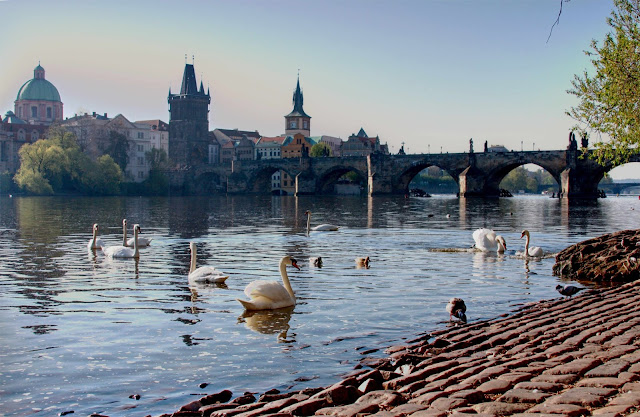Prague is undoubtedly an architectural gem and it only takes a look to the city's skyline to feast your eyes in an endless number of dark towers, domed churches and clustered spires. In fact, Prague is dubbed the "city of a thousand spires" for an obvious reason, and the rich and well preserved architectonical examples of Gothic, Baroque, Renaissance, and Art Nouveau buildings scattered throughout the city make of it a true open door museum.
That said, getting to this short list of 5 places to visit in Prague was no easy task and only the decision of writing a more complete city guide in the future give me some peace of mind. If you only have a weekend, walk around and catch awesome city views from both sides of the Vltava and try not to miss the next 5 spots.
1. ASTRONOMICAL CLOCK AND OLD TOWN SQUARE
The Old Town (Staré Mesto) is the historic center of Prague, and there you'll find the impressive Old Town Square (Staromestské námestí). As it was close to our hotel, it became sort of ground zero for our daily itineraries. There, you'll find the Church of Our Lady before Týn (in the photo bellow), along with numerous other gorgeous old churches, and superb architecture from different eras.
One of the major attractions in the square is the Old Town Hall (Staromestská radnice), where you can find the spectacular early 15th-century Astronomical Clock (Orloj). If you want to enjoy it calmly its better to pass by in the early hours, as its usual to be surrounded by an expectant crowd, specially when we're close to the hour, to see the 12 Apostles and other figures appear in procession across the clock face.
2. CHARLES BRIDGE
You can't go to Prague without crossing (several times!) the iconic Charles Bridge (Karluv Most). Built in 1357, the bridge is particularly famous for 32 statues aligned along its over 600 meters of span, being the one of the revered Saint John of Nepomuk the most recognizable.
To have a more clear view of the bridge and all of these fine statues. its better to be there early in the morning, as it gets quite crowded (subway rush hour crowded, if you get what I mean!). The views from the bridge, over the Vltava river are not to miss and if you have the opportunity, get to the top of the Gothic gates that oversee the bridge from both ends.
3. PRAGUE CASTLE
Located in Hradcany neighborhood, the complex of Prague Castle (Pražský hrad), is one of the city's most visited tourist attractions. Once a walled fortress, the castle has evolved over the centuries and boasts examples of the most leading architectural styles of the last millennium. Within the castle walls you can find St. Vitus Cathedral, St. George's Basilica, the Powder Tower, the Old Royal Palace, and the Golden Lane.
You need no less than half a day to visit all well deserving attractions and must consider that in some cases there will be lines for the entrance. The castle stands on the top of a hill and the views of the city and the river are breathtaking. If you don't have enough time to visit all the monuments, I would urge you not to miss St. Vitus Cathedral.
4. WENCESLAS SQUARE
At the centre of Prague's New Town (Nové Mesto) is the imposing Wenceslas Square (Václavské námestí). Standing in the higher grounds of the enormous rectangular square is the National Museum (unfortunately, didn't have the time to visit it) and along the large avenue you can find numerous other architectural treasures.
Shoppings, restaurants and hotels can be found in both sides of the street and if you appreciate modernist architecture you will find many examples of the early 20th century buildings there. The square was named after the patron saint of Bohemia, whose statue can be seen in the higher end of the square. If you want to see a different version of the equestrian statue of king Wenceslas, just head to the Lucerna Palace to check the sculpture of the patron riding an upside down horse (photo bellow).
5. MUNICIPAL HOUSE
The Prague Municipal House (Obecní dum) is perhaps one of the finest examples of Art Nouveau in the city. Built in 1912, this splendid building houses one of Prague's most important concert venues, the Smetana Hall, and boasts numerous striking architectural features. Its also an historical landmark as it was from its balcony that the independence of Czechoslovakia was officially proclaimed on October 1918.
The interiors are even more impressive, including many fine stained glass windows, important paintings (one of the rooms decorated by Alfons Mucha). You can visit the interior in a guided tour or opt for a concert, or a meal in one of its restaurants.








































